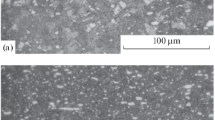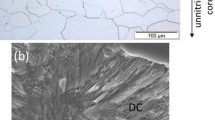Conclusions
-
1.
Nitriding at temperatures above 550° leads to diffusional redistribution of aluminum atoms, which combine with the γ′ phase on the surface. In contrast to aluminum, transition d metals (titanium, vanadium, chromium) are evenly distributed in the α solid solution with nitrogen.
-
2.
Aluminum does not increase the solubility of nitrogen in ferrite and does not form AlN. A study of the processes occurring in the diffusion zone of Fe−Al alloys in relation to the aluminum concentration and nitriding temperature and time showed that aluminum is not a nitride-forming element in ferrite.
-
3.
The hardness of the nitrided case on ferrite with aluminum increases only in the surface zone of γ′ phase, and the hardness of the α solid solution hardly increases, since matrix precipitates of Fe4N and Fe16N2 increase the hardness of ferrite negligibly.
-
4.
Alloys with a high aluminum concentration (6.85%) have a highly developed polygonal structure in the original condition that to a considerable extent aceelerates the diffusion of nitrogen, which is essentially transcrystalline in the given case. Transformations occur in separate local volumes of the diffusion layer in the process of nitriding, especially those that are alloyed — the α → γ′ transformation after 1 h and the γ′ → ε transformation after 3 h.
-
5.
In contrast to aluminum, transition d metals substantially increase the solubility of nitrogen in the α phase and sharply increase the microhardness and reduce the case depth. The effectiveness of the increase in the solubility of nitrogen diminishes in the following order: titanium → vanadium → chromium.
-
6.
The hardening of ferrite alloyed with titanium, vanadium, and chromium is due to the precipitation of nitrides of the alloying elements of the maximum stoichiometric composition with a B1 lattice from the α solid solution supersaturated with nitrogen. The microhardness is highest after nitriding at 550° at the stage of complete coherence of nitrides of the alloying elements and the α matrix. The hardness of ferrite decreases sharply when the coherence is completely disrupted and the nitrides become independent phases.
Similar content being viewed by others
Literature cited
Yu. M. Lakhtin, N. V. Silina, and V. A. Fedchun, ,“Structure and properties of nitrided binary alloys of the Fe−Al, Fe−V, and Fe−Ti systems,” Metalloved. Term. Obrab. Met., No. 1, 2 (1977).
B. Mortimer, P. Grieveson, and K. Jack, Scand. J. Met.,1, 203 (1972).
P. Grieveson, M. Pope, and K. Jack, Scand. J. Met.,2, 29 (1973).
Additional information
Moscow Highway Institute. Translated from Metallovedenie i Termicheskaya Obrabotka Metallov, No. 6, pp. 23–31, June, 1977.
Rights and permissions
About this article
Cite this article
Lakhtin, Y.M., Silina, N.V. The high hardness of alloyed ferrite after nitriding. Met Sci Heat Treat 19, 447–454 (1977). https://doi.org/10.1007/BF00713080
Issue Date:
DOI: https://doi.org/10.1007/BF00713080




